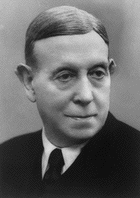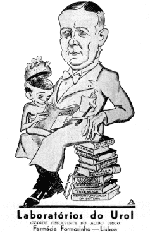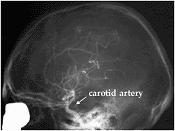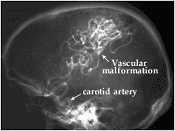|
|
|||||||||||||||||||||||||||||||||||
|
|
|||||||||||||||||||||||||||||||||||
|
|
|||||||||||||||||||||||||||||||||||
|
Egas Moniz (1874-1955)
Antonio Caetano de Abreu Freire Egas Moniz was born in Avanca, municipality of Estarreja, on 29 November 1874, to Fernando Pina Resende Abreu and Maria do Rosário de Almeida de Sousa Abreu. In 1866 he wrote his primary education examination at the Escola do Conde Ferreira in Estarreja. Due to financial difficulties, his father emigrated to Beira (Mozambique) and some of the family’s possessions were placed on auction. It was his uncle, abbot Caetano de Pina Resende Abreu de Sá Freire, who supported his first studies. After completing his primary education, Egas Moniz went to study in the Colégio de São Fiel, in Castelo Branco, completing the last year of his secondary education in the Liceu de Viseu. In 1891, the year in which his father died, he set up residence in Coimbra in order to study Medicine. During the course, his closest relatives passed away, his brother in 1895, his mother in 1898 and his uncle the abbot also in 1898. This was also the date on which he started suffering from gouty rheumatism, an illness that accompanied him throughout his life. In 1901, he married Elvira Macedo Dias, natural of Rio de Janeiro. He completed a post-graduate course in Medicine at the Faculty of Medicine of the University of Coimbra in 1899 and defended his thesis in 1900. A year later, he took his PhD examinations and in 1902, he entered the teaching body of this university as a substitute professor. Initially he worked in the subjects of Anatomy, Histology and, much later, General Pathology. In 1910, he became full professor and in 1911 he moved to the Faculty of Medicine of the University of Lisbon, where he was responsible for the subject of Neurological Practice. He opened up his consulting room in Lisbon and started travelling regularly to other countries, especially to France. Right from his university days, he pursued an intense political activity. He was an active defender of the freedom of expression and thinking and in 1908 he was imprisoned for being involved in the attempted coup d’état of 28 January against the dictatorship of João Franco (1855-1929). He was deputy in several legislative periods, from 1903 to 1917. In 1910, he was initiated in masonry, in the “Loja Simpatia e União”, of Lisbon. In 1917, he founded the Centrist Party, who aimed to unite former progressive monarchs and republicans who drew away from the Evolutionist Party. He stood for an alliance between the capital and work and preconised the application of protection measures to the working classes. Defender of public freedom and individual rights, he led the parliamentary current of the National Republican Party resulting from the alliance between the Centrist Party and the “sidonists”, who supported the coup that established the dictatorship of Sidónio Pais (1872-1918) in 1917. In this same year, he was nominated Minister of Portugal in Madrid and in 1918 he became Minister of Foreign Affairs of the government of Sidónio Pais. In the performance of this last position he presided over the Portuguese delegation in the Peace Conference of Versailles in 1918. A year later, after the assassination of Sidónio Pais, he was replaced by Afonso Costa (1871-1937) and decided to abandon active politics.
He then dedicated himself to his scientific career, after having published the work Um Ano de Política, where he expressed his feelings and opinions on his political path. He was nominated director of the Hospital Escolar de Lisboa in 1922, becoming a permanent member of the Academias das Ciências de Lisboa in 1923. He became chairman of this institution for the first time in 1928, occupying this position several times afterwards. He was director of the Faculty of Medicine of the University of Lisbon between 1929 and 1931. In 1939, at the age of 65, he was attacked in his consulting room by one of his patients, who shot at him eight times, hitting him five times. He survived and in retired 1944, the year of his jubilee. In 1945, he was awarded the Oslo prize and in 1949 he was awarded the Nobel Prize in Physiology or Medicine. He died in Lisbon on 13 December 1955.
Egas Moniz has a vast bibliography, with over 300 titles of his authorship or in collaboration. Besides Medicine, he published other political and literary works. Listed below are only some of the most significant titles of his scientific work: Post-graduation thesis, Alterações anátomo-patológicas na difteria, presented in 1900. PhD thesis, A Vida Sexual - Fisiologia, presented in 1901. Examinations for a contest to become lector of the Faculty of Medicine of the University of Coimbra, in 1902 with the work A Vida Sexual - Patologia. The latter two works were later brought together, with some changes, in his work A Vida Sexual (Fisiologia e Patologia), edited for the first time in 1913 and which became a highly polemical and very sought after work, with 19 editions by 1933. Under the government of Salazar (1889-1970), it was only possible to acquire with a doctor’s prescription. A Neurologia na Guerra, Lisboa, Livraria Ferreira, 1917. Clínica Neurológia, Lisboa, Faculdade de Medicina, 1925. O Padre Faria na História do Hipnotismo, Lisboa, Faculdade de Medicina, 1925. Diagnostic des Tumeurs Cérébrales et Épreuve de l'Encéphalographie Arthérielle, Paris, Masson&Cie, 1931. L'Angiographie Cérébrale. Sea Applications et Résultats en Anatomie, Physiologie et Clinique, Paris, Masson&cie., 1934. Tentatives Opératoires dans le Traitement de Certaines Psychoses, Paris, Masson&Cie., 1936. La Leucotomie Préfrontal. Traitement Chirurgical de Certaines Psychoses, Torino, Baravalle e Falconieri, 1937. Clínica delle Angiografia Cerebrale, Torino, Iter, 1938. Die Cerebrale Arteriographie und Phlebographie, Berlin, Julius Springer, 1940. Trombosis Y Otras Obstrucciones de las Carotidas, Barcelona, Salvat, 1941. Última Lição - Bibliografia, Lisboa, Portugália Editora, 1944. Besides these books, he published many articles in specialised magazines, both Portuguese and foreign, individually and in collaboration with several specialists such as Almeida Lima, Almeida Dias, António Martins, Eduardo Coelho, Amândio Pinto, Luiz Pacheco, Lopo de Carvalho, Romão Loff, Victor Fontes, Cancela de Abreu, Cândido de Oliveira, Abel Alves, Fernando de Almeida, Aleu Saldanha, Pereira Caldas, Diogo Furtado, Ruy de Lacerda, Joaquim Imaginário, Abel Cancela de Abreu, João Lobo Antunes, Cruz e Silva and Lídia Manso Preto.
His two most important discoveries were cerebral angiography, which he achieved in 1927 and prefrontal leucotomy, in 1935. The former was awarded the Oslo Prize in 1945 and the latter the Nobel Prize in Physiology or Medicine in 1949. In order to be able to do a cerebral angiograph, Egas Moniz carried out many experiments, in an attempt to find substances that could be injected into the arteries of the brain so as to make brain vessels visible in x-rays. The opaqueness brought about by the injection of these products provided a contrast, making it possible to detect brain tumours, thus facilitating their treatment. On 28 June 1927, Egas Moniz obtained the first arteriograph of the live human body. This feat brought him great international prestige and became very important in the dissemination of his subsequent research work in the field of psychosurgery. After this research work, Egas Moniz dedicated himself to another project for the treatment of some mental diseases that were one of the most pressing targets of neurological medicine at the time, before the development of pharmacology and psychotropics. It was thought that is was possible to treat some diseases via physical means by cutting the neurons’ interconnecting fibres. The treatment would be done on the prefrontal lobes. This treatment was classified as leucotomy by Egas Moniz himself. Although initially he used a method that consisted of introducing pure alcohol, he later started using a special instrument, which he called a leucotome, with which a small sphere of the white substance of the prefrontal lobes was cut. These operations were carried out by the surgeon Almeida Lima, Egas Moniz’ main co-worker. This method had a rapid dissemination and application in several countries.
Leucotomy was later transformed and developed by the American Walter Freeman, whose method became known as lobotomy. These methods gave rise to much controversy, particularly from the fifties onwards, when alternatives to the treatment of schizophrenia via prescription drugs started coming out. The negative image of the lobotomy and its very often abusive identification with leucotomy is closely related to Freeman’s methodology. Freeman carried out a true lobotomisation “campaign” in the United States, where he performed more than 3500 operations, being imitated by many other psychosurgeons in several countries. Although the leucotomy and lobotomy methods have been practically abandoned nowadays, the controversy continues. Bibliography FERNANDES, Barahona, Egas Moniz, Pioneiro de Descobrimentos Médicos, Lisboa, ICLP, 1983. PEREIRA; Ana Leonor; PITA; João Rui; RODRIGUES, Rosa Maria, Retrato de Egas Moniz, Lisboa, Círculo de Leitores, 1999. PEREIRA; Ana Leonor; PITA; João Rui, org., Egas Moniz em livre exame, Coimbra, Minerva Coimbra, 2000.
|
|||||||||||||||||||||||||||||||||||
 |
|||||||||||||||||||||||||||||||||||
|
|
|||||||||||||||||||||||||||||||||||
| © Instituto Camões 2003-2005 | |||||||||||||||||||||||||||||||||||





